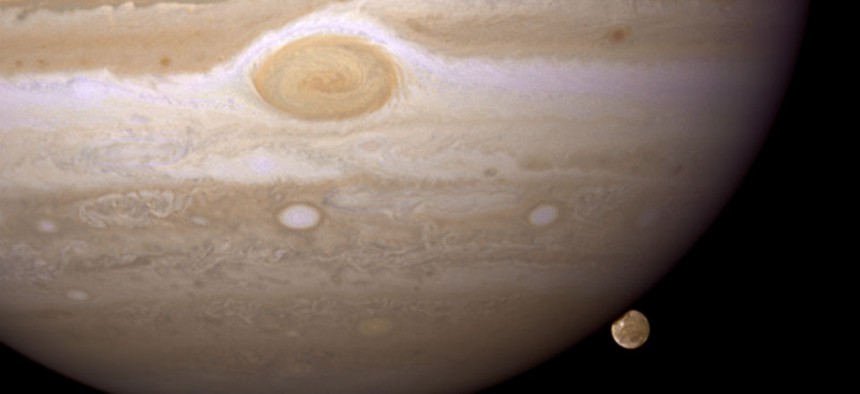NASA Is Building a Tiny Mothership to Explore Distant Lunar Oceans

Jupiter's moon Ganymede playing a game of "peek-a-boo." NASA/AP
In a new approach to planetary science, a small satellite would rain even smaller satellites on Jupiter's moon.
Suppose you’re a planetary scientist. You operate an unmanned spacecraft, surveying a distant moon in our solar system. Years of funding, engineering work, and long-distance space travel have all come together, and at last this machine—to which you have devoted so much of your life—is in place. And it’s just made an incredible discovery.
Maybe it’s a new kind of crater. Or an odd, unexpected mineral. Or the holy grail: liquid water.
It’s thrilling news—years of your career, vindicated! Now you have to wait. And lobby. And hope for the funding to come through. And wait for the next craft to get there.
As Brent Streetman, a researcher at the aerospace technology firm Draper Laboratories, told me earlier this week: “Once we find interesting things, there’s no way to access them. We have to wait for the next cycle of space exploration to that planet.”
Indeed, the NASA scientists tasked with extending humanity’s reach into space have two very different jobs. The first is posed by space and solved by engineering: It’s the actual work of sending tools, instruments, and (sometimes) humans millions of miles, to another place in space, intact. But the second one can be both much more mundane and much more infuriating: It’s the ongoing work of securing funding for space exploration from a capricious and dysfunctional Congress.
A new experimental spacecraft design anticipates the second problem with the techniques of the first. Draper Laboratories received funding this week from NIAC , NASA’s innovative concepts fund, for a two-phase space probe—technology that could both survey a planet and send instruments to its surface.
Where might such a probe go first? Its designers, led by Streetman, think it might be a good way to explore the only orb in the solar system believed to have liquid water: Jupiter’s moon, Europa.

In its first stage, a small satellite about as large as a half-gallon of milk would orbit the moon. Using two highly accurate accelerometers, it could sense small changes in Europa’s gravitational field, eventually mapping the gravity of the entire surface. These detailed gravity maps could then suggest the location of watery oceans below the planet’s surface—or the openings to these oceans.
Once an ocean (or the entryway to one) was found, the probe would begin its second stage. The small satellite would release even smaller instruments over the interesting region. These “chipsats,” each no larger than a fingernail, could enter Europa’s thin atmosphere unharmed and float down to the surface.

“When there is an atmosphere, they flutter down like little pieces of paper, not like a rock,” said John West, leader of the advanced concepts team at Draper. He added that while they expect to lose some of the smaller “chipsats,” enough would be released that useful science could be performed.
Once deployed, the tiny chipsats would then send their measurements back to their orbiting mothership, which would in turn beam them back to Earth.
Both of the mission’s vehicles were pioneered in near-Earth orbit. The gravity-mapping satellite draws on cubesat technology, a set of tools and common plans that let satellites be cheaply produced. Last November, a team of high schoolers put a cubesat in orbit . The even smaller “chipsats” were first deployed as part of the space shuttle Endeavour’s final mission in 2011, in partnership with researchers at Cornell University. Cornell is also consulting on the project.
Europa was last studied at close proximity by NASA’s Galileo spacecraft. Over a decade ago, Galileo orbited Jupiter before the probe's human overlords sent it careening into the gas giant’s atmosphere, in part to keep from contaminating Europa’s surface.






